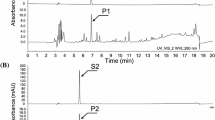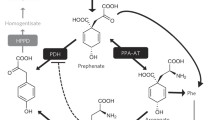Abstract
Plant-specific bioactive compounds including feruloyltyramine (FT), 4-coumaroyltyramine (CT), and caffeoyltyramine (CaT) were simultaneously produced in Escherichia coli by heterologous expression of two biosynthetic genes encoding 4-coumarate:coenzyme A ligase and tyramine N-hydroxycinnamoyltransferase (THT) cloned from Arabidopsis thaliana and pepper, respectively. Simultaneous supplementation of substrates to the recombinant E. coli resulted in the secretion of multiple tyramine derivatives into the medium at high yield: CT (189 mg l−1), FT (135 mg l−1), CaT (40 mg l−1). In addition, the recombinant E. coli also produced, albeit at low concentration, a range of dopamine derivatives such as feruloyldopamine due to THT’s ability to accept dopamine as a substrate.



Similar content being viewed by others
References
Back K, Yin S, Chappell J (1994) Expression of a plant sesquiterpene cyclase gene in Escherichia coli. Arch Biochem Biophys 315:527–532
Back K, Jang SM, Lee BC, Schmidt A, Strack D, Kim KM (2001) Cloning and characterization of a hydroxycinnamoyl-CoA:tyramine N-(hydroxycinnamoyl) transferase induced in response to UV-C and wounding from Capsicum annuum. Plant Cell Physiol 42:475–481
Beekwilder J, Wolswinkel R, Jonker H, Hall R, Ric de Vos CH (2006) Production of resveratrol in recombinant microorganisms. Appl Environ Microbiol 72:5670–5672
Efdi M, Ohguchi K, Akao Y, Nozawa Y, Koketsu M, Ishihara H (2007) N-trans-Feruloyltyramine as a melanin biosynthesis inhibitor. Biol Pharm Bull 30:1972–1974
Ehlting J, Büttner D, Wang Q, Douglas CJ, Somssich IE, Kombrink E (1999) Three 4-coumarate:coenzyme A ligases in Arabidopsis thaliana represent two evolutionarily divergent classes in angiosperms. Plant J 19:9–20
Facchini PJ, Hagel J, Zulak KG (2002) Hydroxycinnamic acid amide metabolism: physiology and biochemistry. Can J Bot 80:577–589
Hagel JM, Facchini PJ (2005) Elevated tyrosine decarboxylase and tyramine hydroxycinnamoyltransferase levels increase wound-induced tyramine-derived hydroxycinnamic acid amide accumulation in transgenic tobacco leaves. Planta 221:904–914
Jang SM, Ishihara A, Back K (2004) Production of coumaroylserotonin and feruloylserotonin in transgenic rice expressing pepper hydroxycinnamoyl-coenzyme A:serotonin N-(hydroxycinnamoyl)transferase. Plant Physiol 135:346–356
Kang S, Kang K, Chung GC, Choi D, Ishihara A, Lee DS, Back K (2006) Functional analysis of the amine substrate specificity domain of pepper tyramine and serotonin N-hydroxycinnamoyltransferases. Plant Physiol 140:704–715
Lee DE, Kang K, Lee SG, Back K (2007) Enhanced synthesis of feruloyltyramine and 4-coumaroyltyramine is associated with tyramine availability in transgenic rice expressing pepper tyramine N-hydroxycinnamoyltransferase. Plant Sci 172:57–63
Mata R, Morales I, Pérez O, Rivero-Cruz I, Acevedo L, Enriquez-Mendoza I, Bye R, Franzblau S, Timmermann B (2004) Antimycobacterial compounds from Piper sanctum. J Nat Prod 67:1961–1968
Minami H, Kim JS, Ikezawa N, Takemura T, Katayama T, Kumagai H, Sato F (2008) Microbial production of plant benzylisoquinoline alkaloids. Proc Natl Acad Sci USA 105:7393–7398
Negrel J, Lherminier J (1987) Peroxidase-mediated integration of tyramine into xylem cell walls of tobacco leaves. Planta 172:494–501
Park J (2007) Caffedymine from cocoa has COX inhibitory activity suppressing the expression of a platelet activation marker, P-selection. J Agric Food Chem 55:2171–2175
Park JB, Schoene N (2002) Synthesis and characterization of N-coumaroyltyramine as a potent phytochemical which arrests human transformed cells via inhibiting protein tyrosine kinases. Biochem Biophys Res Commun 292:1104–1110
Park M, Kang K, Park S, Kim YS, Ha SH, Lee SW, Ahn MJ, Bae JM, Back K (2008) Expression of serotonin derivatives synthetic genes on a single self-processing polypeptide and the production of serotonin derivatives in microbes. Appl Microbiol Biotechnol 81:43–49
Park S, Kang K, Kim YS, Back K (2009) Endosperm-specific expression of tyramine N-hydroxycinnamoyltransferase and tyrosine decarboxylase from a single self-processing polypeptide produces high levels of tyramine derivatives in rice seeds. Biotechnol Lett. doi:10.1007/s10529-009-9951-2
Roh JS, Han JY, Kim JH, Hwang JK (2004) Inhibitory effects of active compounds isolated from safflower (Carthamus tinctorius L.) seeds for melanogenesis. Biol Pharm Bull 27:1976–1978
Schmidt A, Grimm R, Schmidt J, Scheel D, Strack D, Rosahl S (1999) Cloning and expression of a potato cDNA encoding hydroxycinnamoyl-CoA:tyramine N-(hydroxycinnamoyl)transferase. J Biol Chem 274:4273–4280
Seki M, Carninci P, Nishiyama Y, Hayashizaki Y, Shinozaki K (1998) High-efficiency cloning of Arabidopsis full-length cDNA by biotinylated CAP trapper. Plant J 15:707–720
Seki M, Narusaka M, Kamiya A, Ishida J, Satou M, Sakurai T et al (2002) Functional annotation of a full-length Arabidopsis cDNA collection. Science 296:141–145
Von Roepenack-Lahaye E, Newman MA, Schornack S, Hammond-Kosack KE, Lahaye T, Jones JDG, Daniels MJ, Dow JM (2003) p-Coumaroylnoradrenaline, a novel plant metabolite implicated in tomato defense against pathogen. J Biol Chem 278:43373–43383
Yokozawa T, Tanaka T, Kimura T (2001) Examination of the nitric oxide production-suppressing component in Tinospora tuberculata. Biol Pharm Bull 24:1153–1156
Acknowledgements
This work was supported by the Technology Development Program for Agriculture and Forestry, Ministry of Agriculture and Forestry, Republic of Korea. Also, this work was supported by the Korea Science and Engineering Foundation (KOSEF) grant funded by the Korea government (R11-2001-09203001-0) and by the Biotechnology Research Institute of Chonnam National University.
Author information
Authors and Affiliations
Corresponding author
Rights and permissions
About this article
Cite this article
Kang, K., Park, M., Park, S. et al. Production of plant-specific tyramine derivatives by dual expression of tyramine N-hydroxycinnamoyltransferase and 4-coumarate:coenzyme A ligase in Escherichia coli . Biotechnol Lett 31, 1469–1475 (2009). https://doi.org/10.1007/s10529-009-0032-3
Received:
Accepted:
Published:
Issue Date:
DOI: https://doi.org/10.1007/s10529-009-0032-3




